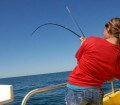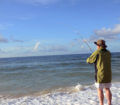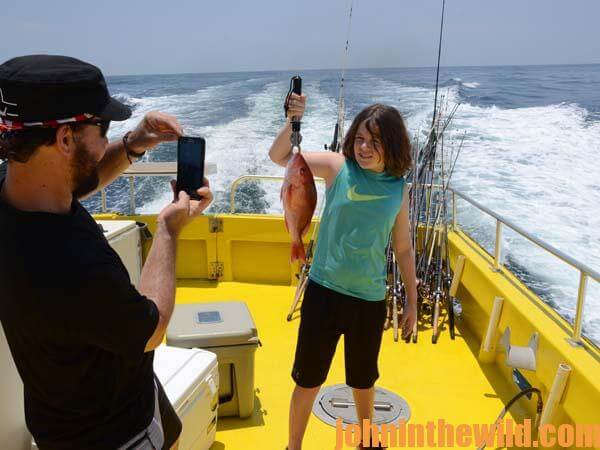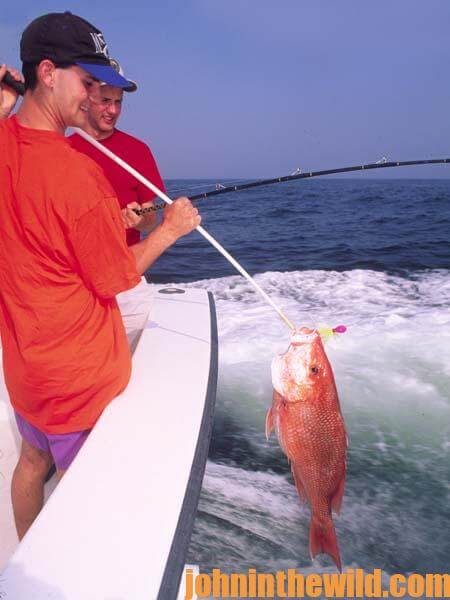 If you’ve watched saltwater fishing TV shows, you’ll often see anglers in fighting chairs on the backs of the boats pumping the rods. When a fish is on the line, an angler generally will pull the rod up to about the 12:00 position, and then drop the rod to about the 3:00 position and wind in the slack, keeping tension on the line while taking up the slack. However, when you’re reef fishing, pumping the rod is one of the quickest and easiest ways to lose your fish on the end of the line. The line is rigged with a three-way swivel tied to the main line. The second eye of the swivel will have about a 3-foot leader, a hook and a bait. The lead is tied to the bottom swivel. Once you’ve hooked the fish and start reeling it in, if you bring the rod to the12:00 position and drop the rod tip to the 3:00 position you’re leaving slack in the line. Then if you reel as you drop your rod tip, the fish can get off the hook, or your lead will fall away from the fish, which helps pop the hook out of the fish’s mouth.
If you’ve watched saltwater fishing TV shows, you’ll often see anglers in fighting chairs on the backs of the boats pumping the rods. When a fish is on the line, an angler generally will pull the rod up to about the 12:00 position, and then drop the rod to about the 3:00 position and wind in the slack, keeping tension on the line while taking up the slack. However, when you’re reef fishing, pumping the rod is one of the quickest and easiest ways to lose your fish on the end of the line. The line is rigged with a three-way swivel tied to the main line. The second eye of the swivel will have about a 3-foot leader, a hook and a bait. The lead is tied to the bottom swivel. Once you’ve hooked the fish and start reeling it in, if you bring the rod to the12:00 position and drop the rod tip to the 3:00 position you’re leaving slack in the line. Then if you reel as you drop your rod tip, the fish can get off the hook, or your lead will fall away from the fish, which helps pop the hook out of the fish’s mouth.
That’s why Captain Randy Boggs of the “Reel Surprise,” docked at San Roc Cay Marina in Orange Beach, Alabama, says, “Try to keep your rod perpendicular to the surface of the water. Slowly and steadily, start reeling the fish up. When the fish takes the drag, stop reeling, and if the fish stops pulling the drag on your reel, start winding. When we’re catching reef fish on circle hooks, slow, steady pressure on the fish’s jaw is the best way to get that fish up to the surface without losing it. When the fish reaches the surface, don’t try to throw it in the boat, but call for the deck hand. If the fish is small enough to use this tactic, the deck hand will hand line your fish into the boat. On a bigger fish, he’ll gaff the fish and bring it on board.
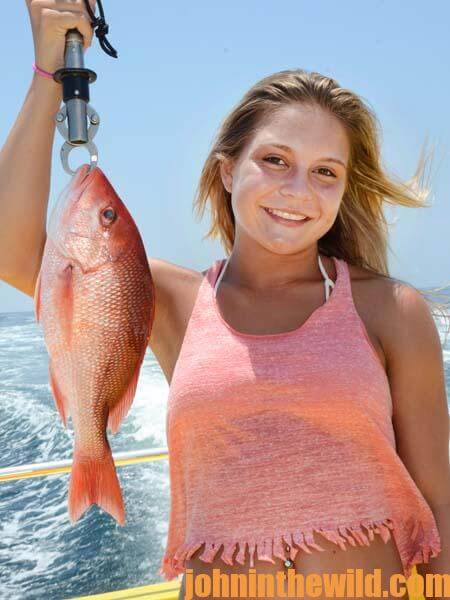 “To get your bait to the bottom, your equipment must have a heavy piece of lead on it. If you try to jerk the fish into the boat, you’ll have a heavy piece of lead flying ahead of the fish. More than likely, as the lead is flying over the side of the boat, someone will get hit in the head with it. When you put enough pressure on a fish that’s just under the surface or right on the surface of the water, more than likely, you’ll tear the hook out of the fish’s mouth before you can jerk it into the boat. So, if you don’t want to lose your fish or injure yourself or someone else, leave the fish in the water. Then once you get the fish close to the surface, call for the deck hand to land the fish properly.”
“To get your bait to the bottom, your equipment must have a heavy piece of lead on it. If you try to jerk the fish into the boat, you’ll have a heavy piece of lead flying ahead of the fish. More than likely, as the lead is flying over the side of the boat, someone will get hit in the head with it. When you put enough pressure on a fish that’s just under the surface or right on the surface of the water, more than likely, you’ll tear the hook out of the fish’s mouth before you can jerk it into the boat. So, if you don’t want to lose your fish or injure yourself or someone else, leave the fish in the water. Then once you get the fish close to the surface, call for the deck hand to land the fish properly.”
Bonus Tip: If you’re taking food and drinks on your reef fishing trip/party boat, one product will make the trip far more enjoyable – Harvest Clean. This spray-on hand sanitizer has a citrus smell and kills any germs or bacteria on your hands. Too, when you start to take a bite of your sandwich, drink your water or soft drinks, your hands won’t smell like the fish you’ve just been handling. Also, if you’re handling fresh-caught fish and cut bait all day, you don’t want to have that same aroma on your hands. When my hands become slippery from handling fish and bait, being able to spray my hands with Harvest Clean allows me to wipe my hands off, feel fresher and get a grip on the next fish that comes on board quickly and easily.
 I enjoy party boat fishing. I like to catch fish, have the photo opportunities, meet new friends and spend time with family and friends who go on the trip with me. School starts soon. To take a trip that will make memories to last a lifetime that you’ll never forget, gather up your youngsters, friends and family for a party boat offshore fishing trip now.
I enjoy party boat fishing. I like to catch fish, have the photo opportunities, meet new friends and spend time with family and friends who go on the trip with me. School starts soon. To take a trip that will make memories to last a lifetime that you’ll never forget, gather up your youngsters, friends and family for a party boat offshore fishing trip now.
To learn more, click on these videos: https://www.youtube.com/playlist?list=PLGQmmVVCpUzqnVbg9ITi8EJz8Fzpz6P1W
You can call Captain Randy Boggs at 251-981-7173 or email at info@reelsurprisecharters.com.
For more information on fishing for saltwater species, get John’s eBooks “Alabama’s Offshore Saltwater Fishing: A Year-Round Guide for Catching Over 15 Species of Fish” and “Fishing Mississippi’s Gulf Coast and Visitor’s Guide.” Click here to get these books.

